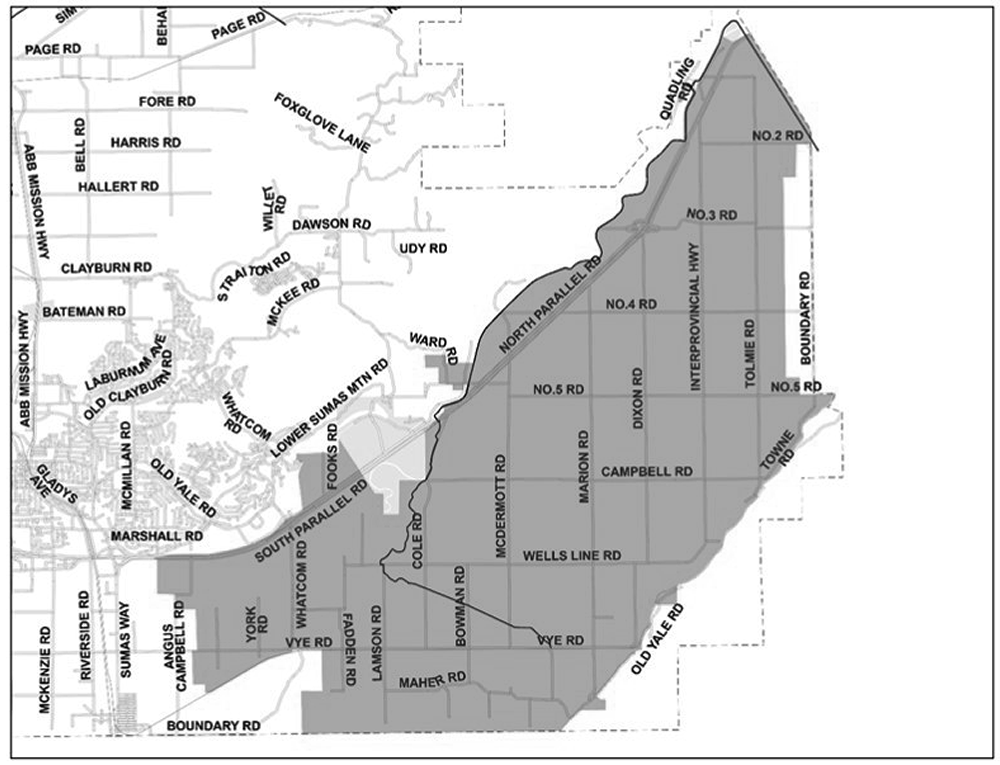Regulation BEFORE repealed by BC Reg 184/2024, effective July 8, 2024.
| B.C. Reg. 1/2022 O.C. 7/2022 | Deposited January 10, 2022 effective November 17, 2021 |
Emergency Program
Milk Industry Standards Exception Regulation
Definitions
1 In this regulation,
"Act" means the Emergency Program Act;
"MPN" means most probable number.
Exception — potable water
2 (1) This section applies in respect of a dairy farm that
(a) is located entirely or partially within the area shaded in red on the map set out in the Schedule, and
(b) uses a water supply that is subject to a public advisory to not use, or to boil, for drinking water.
(2) As an exception to section 16.2 (1) (a) and (2) of the Milk Industry Standards Regulation, B.C. Reg. 464/81, a dairy farmer must ensure that
(a) each milking parlour on the dairy farm is equipped with a pressurized hot and cold water system that is capable of sanitizing all equipment in the milking parlour and permits the effective cleaning of the interior of the milking parlour, and
(b) before water supplied by the water system is used to sanitize equipment in the milking parlour or to clean the interior of the milking parlour,
(i) the requirements of the chlorination protocol set out in subsection (5) are met in respect of the water and the result of the test referred to in subsection (5) (b) indicates a chlorine concentration of at least 150 parts per million, or
(ii) the requirements of the testing protocol set out in subsection (6) are met in respect of the water and the 2 most recent test results received from the laboratory referred to in subsection (6) (b) indicate
(A) a coliform bacteria level of less than 10 MPN per 100 ml, and
(B) non-detectable levels of Escherichia coli bacteria per 100 ml.
(3) As an exception to section 16.5 (1) (b) of the Milk Industry Standards Regulation, a dairy farmer must ensure that
(a) each milk house on the dairy farm is equipped with a pressurized hot and cold water system that meets the requirements of subparagraphs (i) and (ii) of that paragraph, and
(b) before water supplied by the water system is used to sanitize equipment in the milk house, the milk house floor or the farm holding tank,
(i) the requirements of the chlorination protocol set out in subsection (5) are met in respect of the water and the result of the test referred to in subsection (5) (b) indicates a chlorine concentration of at least 150 parts per million, or
(ii) the requirements of the testing protocol set out in subsection (6) are met in respect of the water and the 2 most recent test results received from the laboratory referred to in subsection (6) (b) indicate
(A) a coliform bacteria level of less than 10 MPN per 100 ml, and
(B) non-detectable levels of Escherichia coli bacteria per 100 ml.
(4) As an exception to section 42 (2) (b) of the Milk Industry Standards Regulation, a dairy farmer must ensure that where a milk house contains a farm holding tank,
(a) the milk house is provided with a hose of adequate length for work purposes, with a nozzle, connected to a pressurized hot and cold water system by means of mixing taps or valves, and
(b) before water supplied by the water system is used for sanitizing,
(i) the requirements of the chlorination protocol set out in subsection (5) are met in respect of the water and the result of the test referred to in subsection (5) (b) indicates a chlorine concentration of at least 150 parts per million, or
(ii) the requirements of the testing protocol set out in subsection (6) are met in respect of the water and the 2 most recent test results received from the laboratory referred to in subsection (6) (b) indicate
(A) a coliform bacteria level of less than 10 MPN per 100 ml, and
(B) non-detectable levels of Escherichia coli bacteria per 100 ml.
(5) For the purposes of this section, a chlorination protocol requires the following steps:
(a) the water is treated with chlorine before each use for sanitizing;
(b) a test strip approved by an inspector is used to test the chlorination level of the water before each use for sanitizing;
(c) each chlorination test result is reported to an inspector daily.
(6) For the purposes of this section, a testing protocol requires the following steps:
(a) a sample is taken of the water at least
(ii) on the day of each raw milk pickup, if the 2 most recent test results received from the laboratory referred to in paragraph (b) indicate
(A) a coliform bacteria level of less than 10 MPN per 100 ml, and
(B) non-detectable levels of Escherichia coli bacteria per 100 ml;
(b) each water sample is submitted without delay to a laboratory approved by an inspector for testing for microbial contamination;
(c) each microbial contamination test result received from the laboratory is reported to an inspector without delay.
(7) An inspector may vary a requirement set out in this section if satisfied that it is reasonably necessary to prevent the contamination of raw milk.
(8) A failure to comply with this section is to be treated as though it were a failure to comply with the Milk Industry Act.
Exception — penalties
3 As an exception to the Milk Industry Standards Regulation, sections 112.2 (a) and (b) and 112.3 (a) and (b) of that regulation do not apply.
Application
4 This regulation applies from November 17, 2021 to the end of the last extension of the emergency declared on that date under the Act.

[Provisions relevant to the enactment of this regulation: Emergency Program Act, R.S.B.C. 1996, c. 111, ss. 10.1 and 10.2.]